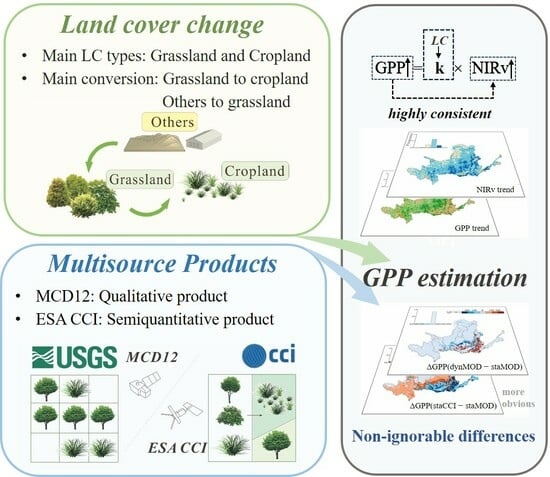Non-Ignorable Differences in NIRv-Based Estimations of Gross Primary Productivity Considering Land Cover Change and Discrepancies in Multisource Products
Abstract
:1. Introduction
2. Materials and Methods
2.1. Study Area
2.2. Land Cover Data and Vegetated Grid Cells of Interest
2.3. NIRv and GPP Calculations
2.4. Statistical Analysis
3. Results
3.1. Land Cover Change
3.2. GPP Estimation under the Different Schemes of Land Cover
3.3. Difference in Trends of GPP Derived from NIRv
4. Discussion
4.1. Relationship between NIRv and GPP
4.2. Reliability of the Estimated GPP
4.3. Uncertainties and Further Studies
5. Conclusions
Supplementary Materials
Author Contributions
Funding
Data Availability Statement
Acknowledgments
Conflicts of Interest
References
- Ryu, Y.; Berry, J.A.; Baldocchi, D.D. What is global photosynthesis? History, uncertainties and opportunities. Remote Sens. Environ. 2019, 237, 95–114. [Google Scholar] [CrossRef]
- Beer, C.; Reichstein, M.; Tomelleri, E.; Ciais, P.; Jung, M.; Carvalhais, N.; Rödenbeck, C.; Arain, M.A.; Baldocchi, D.D.; Bonan, G.B.; et al. Terrestrial gross carbon dioxide uptake: Global distribution and covariation with climate. Science 2010, 329, 834–838. [Google Scholar] [CrossRef]
- Ito, A.; Inatomi, M.; Huntzinger, D.N.; Schwalm, C.; Michalak, A.M.; Cook, R.; King, A.W.; Mao, J.; Wei, Y.; Mac Post, W.; et al. Decadal trends in the seasonal-cycle amplitude of terrestrial CO2 exchange resulting from the ensemble of terrestrial biosphere models. Tellus B Chem. Phys. Meteorol. 2016, 68, 28968. [Google Scholar] [CrossRef]
- Piao, S.L.; Sitch, S.; Ciais, P.; Friedlingstein, P.; Peylin, P.; Wang, X.; Ahlstrom, A.; Anav, A.; Canadell, J.G.; Cong, N.; et al. Evaluation of terrestrial carbon cycle models for their response to climate variability and to CO2 trends. Glob. Chang. Biol. 2013, 19, 2117–2132. [Google Scholar] [CrossRef]
- Chen, M.; Rafique, R.; Asrar, G.R.; Bond-Lamberty, B.; Ciais, P.; Zhao, F.; Reyer, C.P.O.; Ostberg, S.; Chang, J.F.; Ito, A.; et al. Regional contribution to variability and trends of global gross primary productivity. Environ. Res. Lett. 2017, 12, 105005. [Google Scholar] [CrossRef]
- Xiao, J.F.; Chevallier, F.; Gomez, C.; Guanter, L.; Hicke, J.A.; Huete, A.R.; Ichii, K.; Ni, W.J.; Pang, Y.; Rahman, A.F.; et al. Remote sensing of the terrestrial carbon cycle: A review of advances over 50 years. Remote Sens. Environ. 2019, 233, 111383. [Google Scholar] [CrossRef]
- Tramontana, G.; Ichii, K.; Camps-Valls, G.; Tomelleri, E.; Papale, D. Uncertainty analysis of gross primary production upscaling using Random Forests, remote sensing and eddy covariance data. Remote Sens. Environ. 2015, 168, 360–373. [Google Scholar] [CrossRef]
- Yang, F.H.; Ichii, K.; White, M.A.; Hashimoto, H.; Michaelis, A.R.; Votava, P.; Zhu, A.X.; Huete, A.; Running, S.W.; Nemani, R.R. Developing a continental-scale measure of gross primary production by combining MODIS and AmeriFlux data through Support Vector Machine approach. Remote Sens. Environ. 2007, 110, 109–122. [Google Scholar] [CrossRef]
- Fensholt, R.; Sandholt, I.; Rasmussen, M.S. Evaluation of MODIS LAI, fAPAR and the relation between fAPAR and NDVI in a semi-arid environment using in situ measurements. Remote Sens. Environ. 2004, 91, 490–507. [Google Scholar] [CrossRef]
- Field, C.B.; Randerson, J.T.; Malmstrom, C.M. Global net primary production: Combining ecology and remote sensing. Remote Sens. Environ. 1995, 51, 74–88. [Google Scholar] [CrossRef]
- Gan, R.; Zhang, Y.Q.; Shi, H.; Yang, Y.T.; Eamus, D.; Cheng, L.; Chiew, F.H.S.; Yu, Q. Use of satellite leaf area index estimating evapotranspiration and gross assimilation for Australian ecosystems. Ecohydrology 2018, 11, e1974. [Google Scholar] [CrossRef]
- Zhang, Y.Q.; Kong, D.D.; Gan, R.; Chiew, F.H.S.; McVicar, T.R.; Zhang, Q.; Yang, Y.T. Coupled estimation of 500 m and 8-day resolution global evapotranspiration and gross primary production in 2002–2017. Remote Sens. Environ. 2019, 222, 165–182. [Google Scholar] [CrossRef]
- Zhang, Y.Q.; Liu, C.M.; Shen, Y.J.; Kondoh, A.; Tang, C.Y.; Tanaka, T.; Shimada, J. Measurement of evapotranspiration in a winter wheat field. Hydrol. Processes 2002, 16, 2805–2817. [Google Scholar] [CrossRef]
- Chen, A.; Mao, J.F.; Ricciuto, D.; Lu, D.; Xiao, J.F.; Li, X.; Thornton, P.E.; Knapp, A.K. Seasonal changes in GPP/SIF ratios and their climatic determinants across the Northern Hemisphere. Glob. Chang. Biol. 2021, 27, 5186–5197. [Google Scholar] [CrossRef]
- Bai, J.; Zhang, H.L.; Sun, R.; Li, X.; Xiao, J.F.; Wang, Y. Estimation of global GPP from GOME-2 and OCO-2 SIF by considering the dynamic variations of GPP-SIF relationship. Agric. For. Meteorol. 2022, 326, 109180. [Google Scholar] [CrossRef]
- Badgley, G.; Field, C.B.; Berry, J.A. Canopy near-infrared reflectance and terrestrial photosynthesis. Sci. Adv. 2017, 3, e1602244. [Google Scholar] [CrossRef]
- Liu, L.Y.; Liu, X.J.; Chen, J.D.; Du, S.S.; Ma, Y.; Qian, X.J.; Chen, S.Y.; Peng, D.L. Estimating maize GPP using near-infrared radiance of vegetation. Sci. Remote Sens. 2020, 2, 100009. [Google Scholar] [CrossRef]
- Wu, G.H.; Guan, K.Y.; Jiang, C.Y.; Peng, B.; Kimm, H.; Chen, M.; Yang, X.; Wang, S.; Suyker, A.E.; Bernacchi, C.J.; et al. Radiance-based NIRv as a proxy for GPP of corn and soybean. Environ. Res. Lett. 2020, 15, 034009. [Google Scholar] [CrossRef]
- Baldocchi, D.D.; Ryu, Y.; Dechant, B.; Eichelmann, E.; Hemes, K.; Ma, S.; Sanchez, C.R.; Shortt, R.; Szutu, D.; Valach, A.; et al. Outgoing near-infrared radiation from vegetation scales with canopy photosynthesis across a spectrum of function, structure, physiological capacity, and weather. J. Geophys. Res. Biogeosci. 2020, 125, e2019JG005534. [Google Scholar] [CrossRef]
- Dechant, B.; Ryu, Y.; Badgley, G.; Zeng, Y.L.; Berry, J.A.; Zhang, Y.G.; Goulas, Y.; Li, Z.H.; Zhang, Q.; Kang, M.; et al. Canopy structure explains the relationship between photosynthesis and sun-induced chlorophyll fluorescence in crops. Remote Sens. Environ. 2020, 241, 111733. [Google Scholar] [CrossRef]
- Badgley, G.; Anderegg, L.D.L.; Berry, J.A.; Field, C.B. Terrestrial gross primary production: Using NIRv to scale from site to globe. Glob. Chang. Biol. 2019, 25, 3731–3740. [Google Scholar] [CrossRef] [PubMed]
- Wang, S.H.; Zhang, Y.G.; Ju, W.M.; Qiu, B.; Zhang, Z.Y. Tracking the seasonal and inter-annual variations of global gross primary production during last four decades using satellite near-infrared reflectance data. Sci. Total Environ. 2021, 755, 142569. [Google Scholar] [CrossRef] [PubMed]
- Erb, K.-H.; Kastner, T.; Luyssaert, S.; Houghton, R.A.; Kuemmerle, T.; Olofsson, P.; Haberl, H. COMMENTARY: Bias in the attribution of forest carbon sinks. Nat. Clim. Chang. 2013, 3, 854–856. [Google Scholar] [CrossRef]
- Kimball, H.L.; Selmants, P.C.; Moreno, A.; Running, S.W.; Giardina, C.P. Evaluating the role of land cover and climate uncertainties in computing gross primary production in Hawaiian Island ecosystems. PLoS ONE 2017, 12, e0184466. [Google Scholar] [CrossRef]
- Liu, S.S.; Du, W.; Su, H.; Wang, S.Q.; Guan, Q.F. Quantifying Impacts of land-use/cover change on urban vegetation gross primary production: A case study of Wuhan, China. Sustainability 2018, 10, 714. [Google Scholar] [CrossRef]
- Zhang, Y.L.; Song, C.H.; Hwang, T.; Novick, K.; Coulston, J.W.; Vose, J.; Dannenberg, M.P.; Hakkenberg, C.R.; Mao, J.; Woodcock, C.E. Land cover change-induced decline in terrestrial gross primary production over the conterminous United States from 2001 to 2016. Agric. For. Meteorol. 2021, 308, 108609. [Google Scholar] [CrossRef]
- Jin, J.X.; Yan, T.; Zhu, Q.S.; Wang, Y.; Guo, F.S.; Liu, Y.; Hou, W.Y. Heterogeneity of land cover data with discrete classes obscured remotely-sensed detection of sensitivity of forest photosynthesis to climate. Int. J. Appl. Earth Obs. Geoinf. 2021, 104, 102567. [Google Scholar] [CrossRef]
- Cracknell, A.P.; Kanniah, K.D.; Tan, K.P.; Wang, L. Evaluation of MODIS gross primary productivity and land cover products for the humid tropics using oil palm trees in Peninsular Malaysia and Google Earth imagery. Int. J. Remote Sens. 2013, 34, 7400–7423. [Google Scholar] [CrossRef]
- Li, W.; MacBean, N.; Ciais, P.; Defourny, P.; Lamarche, C.; Bontemps, S.; Houghton, R.A.; Peng, S. Gross and net land cover changes in the main plant functional types derived from the annual ESA CCI land cover maps (1992–2015). Earth Syst. Sci. Data 2018, 10, 219–234. [Google Scholar] [CrossRef]
- Wang, L.H.; Jin, J.X. Uncertainty Analysis of Multisource Land Cover Products in China. Sustainability 2021, 13, 8857. [Google Scholar] [CrossRef]
- Ji, Q.L.; Liang, W.; Fu, B.J.; Zhang, W.B.; Yan, J.W.; Lü, Y.H.; Yue, C.; Jin, Z.; Lan, Z.Y.; Li, S.Y.; et al. Mapping land use/cover dynamics of the Yellow River Basin from 1986 to 2018 supported by Google Earth Engine. Remote Sens. 2021, 13, 1299. [Google Scholar] [CrossRef]
- Tian, F.; Liu, L.Z.; Yang, J.H.; Wu, J.-H. Vegetation greening in more than 94% of the Yellow River Basin (YRB) region in China during the 21st century caused jointly by warming and anthropogenic activities. Ecol. Indic. 2021, 125, 107479. [Google Scholar] [CrossRef]
- Kong, D.X.; Miao, C.Y.; Wu, J.W.; Duan, Q.Y. Impact assessment of climate change and human activities on net runoff in the Yellow River Basin from 1951 to 2012. Ecol. Eng. 2016, 91, 566–573. [Google Scholar] [CrossRef]
- Cao, S.X.; Chen, L.; Yu, X.X. Impact of China’s Grain for Green Project on the landscape of vulnerable arid and semi-arid agricultural regions: A case study in northern Shaanxi Province. J. Appl. Ecol. 2009, 46, 536–543. [Google Scholar] [CrossRef]
- He, Z.H.; Gong, K.Y.; Zhang, Z.L.; Dong, W.B.; Feng, H.; Yu, Q.; He, J.Q. What is the past, present, and future of scientific research on the Yellow River Basin? -A bibliometric analysis. Agric. Water Manag. 2022, 262, 207404. [Google Scholar] [CrossRef]
- Liu, J.G.; Li, S.X.; Ouyang, Z.Y.; Tam, C.; Chen, X.D. Ecological and socioeconomic effects of China’s policies for ecosystem services. Proc. Natl. Acad. Sci. USA 2008, 105, 9477–9482. [Google Scholar] [CrossRef]
- Lu, Q.S.; Xu, B.; Liang, F.Y.; Gao, Z.Q.; Ning, J.C. Influences of the Grain-for-Green project on grain security in southern China. Ecol. Indic. 2013, 34, 616–622. [Google Scholar] [CrossRef]
- Li, C.C.; Zhang, Y.Q.; Shen, Y.J.; Yu, Q. Decadal water storage decrease driven by vegetation changes in the Yellow River Basin. Sci. Bull. 2020, 65, 1859–1861. [Google Scholar] [CrossRef]
- Wang, T.; Yang, M.H. Land use and land cover change in China’s Loess Plateau: The impacts of climate change, urban expansion and Grain for Green project implementation. Appl. Ecol. Environ. Res. 2018, 16, 4145–4163. [Google Scholar] [CrossRef]
- Chen, Y.P.; Wang, K.B.; Lin, Y.S.; Shi, W.Y.; Song, Y.; He, X.H. Balancing green and grain trade. Nat. Geosci. 2015, 8, 739–741. [Google Scholar] [CrossRef]
- Friedl, M.A.; Sulla-Menashe, D.; Tan, B.; Schneider, A.; Ramankutty, N.; Sibley, A.; Huang, X. MODIS Collection 5 global land cover: Algorithm refinements and characterization of new datasets. Remote Sens. Environ. 2010, 114, 168–182. [Google Scholar] [CrossRef]
- Li, W.; Ciais, P.; MacBean, N.; Peng, S.S.; Defourny, P.; Bontemps, S. Major forest changes and land cover transitions based on plant functional types derived from the ESA CCI Land Cover product. Int. J. Appl. Earth Obs. Geoinf. 2016, 47, 30–39. [Google Scholar] [CrossRef]
- Poulter, B.; MacBean, N.; Hartley, A.; Khlystova, I.; Arino, O.; Betts, R.; Bontemps, S.; Boettcher, M.; Brockmann, C.; Defourny, P.; et al. Plant functional type classification for earth system models: Results from the European Space Agency’s Land Cover Climate Change Initiative. Geosci. Model Dev. 2015, 8, 2315–2328. [Google Scholar] [CrossRef]
- Duckworth, J.C.; Kent, M.; Ramsay, P.M. Plant functional types: An alternative to taxonomic plant community description in biogeography? Prog. Phys. Geogr. Earth Environ. 2000, 24, 515–542. [Google Scholar] [CrossRef]
- Nowosad, J.; Stepinski, T.F.; Netzel, P. Global assessment and mapping of changes in mesoscale landscapes: 1992–2015. Int. J. Appl. Earth Obs. Geoinf. 2019, 78, 332–340. [Google Scholar] [CrossRef]
- Fang, J.Y.; Piao, S.L.; He, J.S.; Ma, W.H. Increasing terrestrial vegetation activity in China, 1982–1999. Sci. China Ser. C-Life Sci. 2004, 47, 229–240. [Google Scholar] [CrossRef]
- Pedelty, J.; Devadiga, S.; Masuoka, E.; Brown, M.; Pinzon, J.; Tucker, C.; Roy, D.; Ju, J.; Vermote, E.; Prince, S.; et al. Generating a long-term land data record from the AVHRR and MODIS instruments. In Proceedings of the IEEE International Geoscience and Remote Sensing Symposium, Barcelona, Spain, 23–27 July 2007. [Google Scholar]
- Ji, Y.Y.; Jin, J.X.; Zhu, Q.S.; Zhou, S.J.; Wang, Y.; Wang, P.X.; Xiao, Y.Y.; Guo, F.S.; Lin, X.D.; Xu, J.H. Unbalanced forest displacement across the coastal urban groups of eastern China in recent decades. Sci. Total Environ. 2020, 705, 135900. [Google Scholar] [CrossRef]
- Zhu, Q.S.; Jin, J.X.; Wang, P.X.; Ji, Y.Y.; Xiao, Y.Y.; Guo, F.S.; Deng, C.S.; Qu, L.H. Contrasting Trends of Forest Coverage between the Inland and Coastal Urban Groups of China over the Past Decades. Sustainability 2019, 11, 4451. [Google Scholar] [CrossRef]
- Fernandes, R.; Leblanc, S.G. Parametric (modified least squares) and non-parametric (Theil–Sen) linear regressions for predicting biophysical parameters in the presence of measurement errors. Remote Sens. Environ. 2005, 95, 303–316. [Google Scholar] [CrossRef]
- Kruskal, W.H.; Wallis, W.A. Use of ranks in one-criterion variance analysis. J. Am. Stat. Assoc. 1952, 47, 583–621. [Google Scholar] [CrossRef]
- Dunn, O.J. Multiple comparisons using rank sums. Technometrics 1964, 6, 241–252. [Google Scholar] [CrossRef]
- Wang, L.H.; Zhang, Y.Q.; Ma, N.; Song, P.L.; Tian, J.; Zhang, X.Z.; Xu, Z.W. Diverse responses of canopy conductance to heatwaves. Agric. For. Meteorol. 2023, 335, 109453. [Google Scholar] [CrossRef]
- Robinson, N.P.; Allred, B.W.; Smith, W.K.; Jones, M.O.; Moreno, A.; Erickson, T.A.; Naugle, D.E.; Running, S.W. Terrestrial primary production for the conterminous United States derived from Landsat 30 m and MODIS 250 m. Remote Sens. Ecol. Conserv. 2018, 4, 264–280. [Google Scholar] [CrossRef]
- Pastorello, G.; Trotta, C.; Canfora, E.; Chu, H.S.; Christianson, D.; Cheah, Y.W.; Poindexter, C.; Chen, J.Q.; Elbashandy, A.; Humphrey, M.; et al. The FLUXNET2015 dataset and the ONEFlux processing pipeline for eddy covariance data. Sci. Data 2010, 7, 225. [Google Scholar] [CrossRef]
- Yu, H.; Qi, D.H.; Zhang, Y.P.; Song, Q.H.; Fei, X.H.; Sha, L.Q.; Liu, Y.T.; Zhou, W.J.; Zhou, L.G.; Deng, X.B.; et al. An observation dataset of carbon and water fluxes in Xishuangbanna rubber plantations from 2010 to 2014. Sci. Data Bank 2021, 6, 92–103. [Google Scholar] [CrossRef]
- Kato, T.; Tang, Y.; Gu, S.; Hirota, M.; Du, M.; Li, Y.; Zhao, X.Q. Temperature and biomass influences on interannual changes in CO2 exchange in an alpine meadow on the Qinghai-Tibetan Plateau. Glob. Chang. Biol. 2006, 12, 1285–1298. [Google Scholar] [CrossRef]
- Li, Y.N. (2003–2005) FLUXNET2015 CN-Ha2 Haibei Shrubland. Dataset 2016. [Google Scholar] [CrossRef]
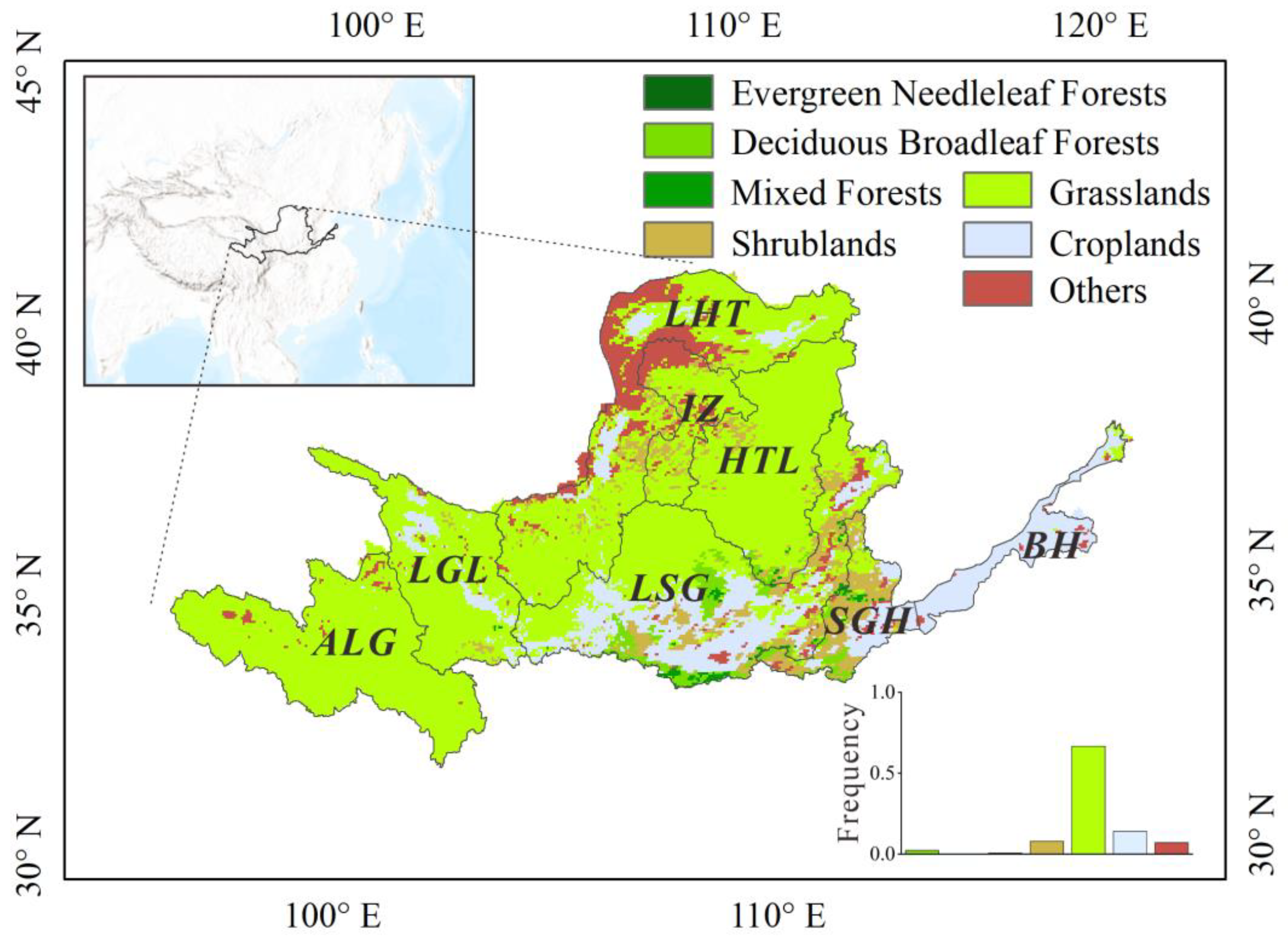
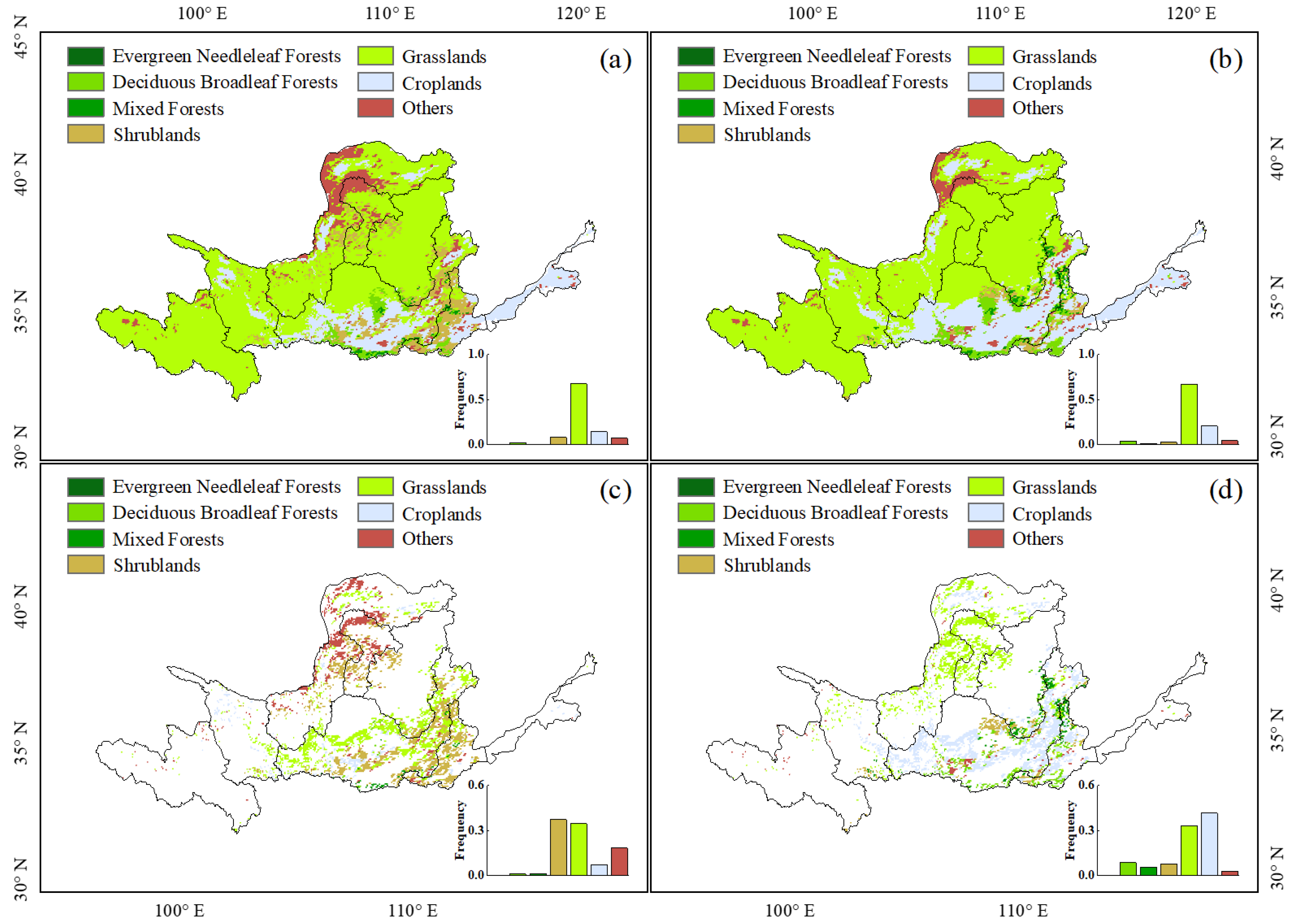
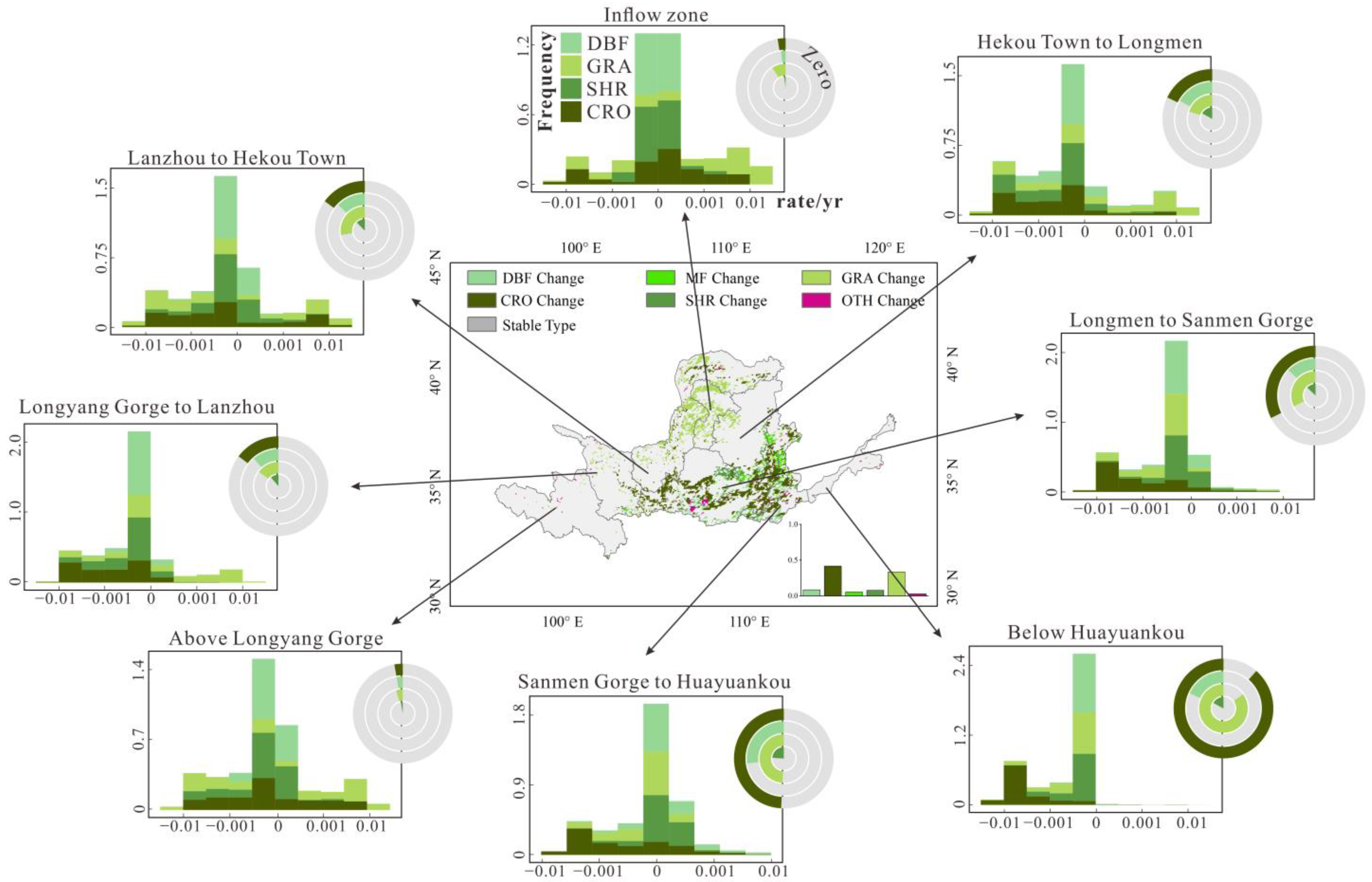

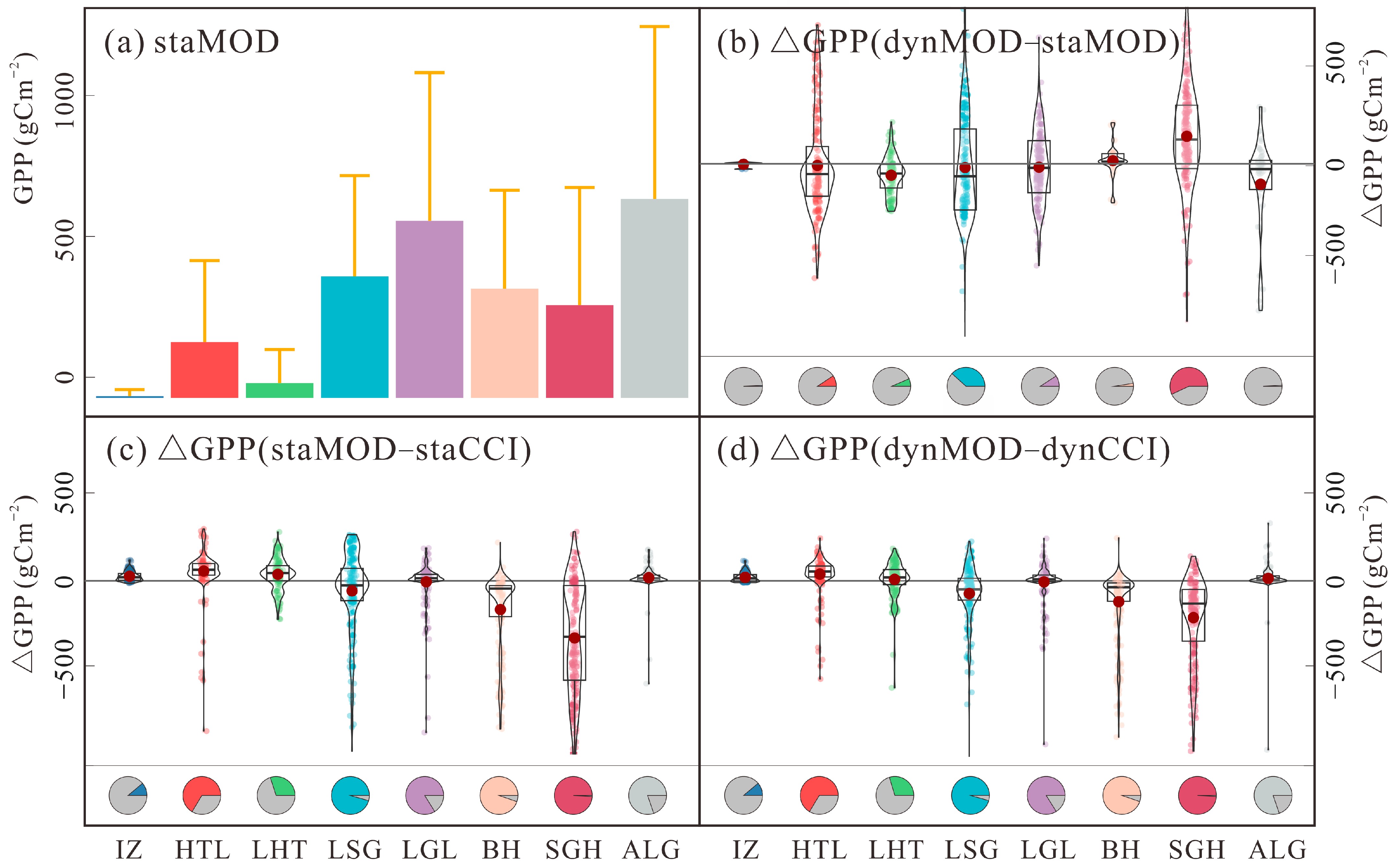
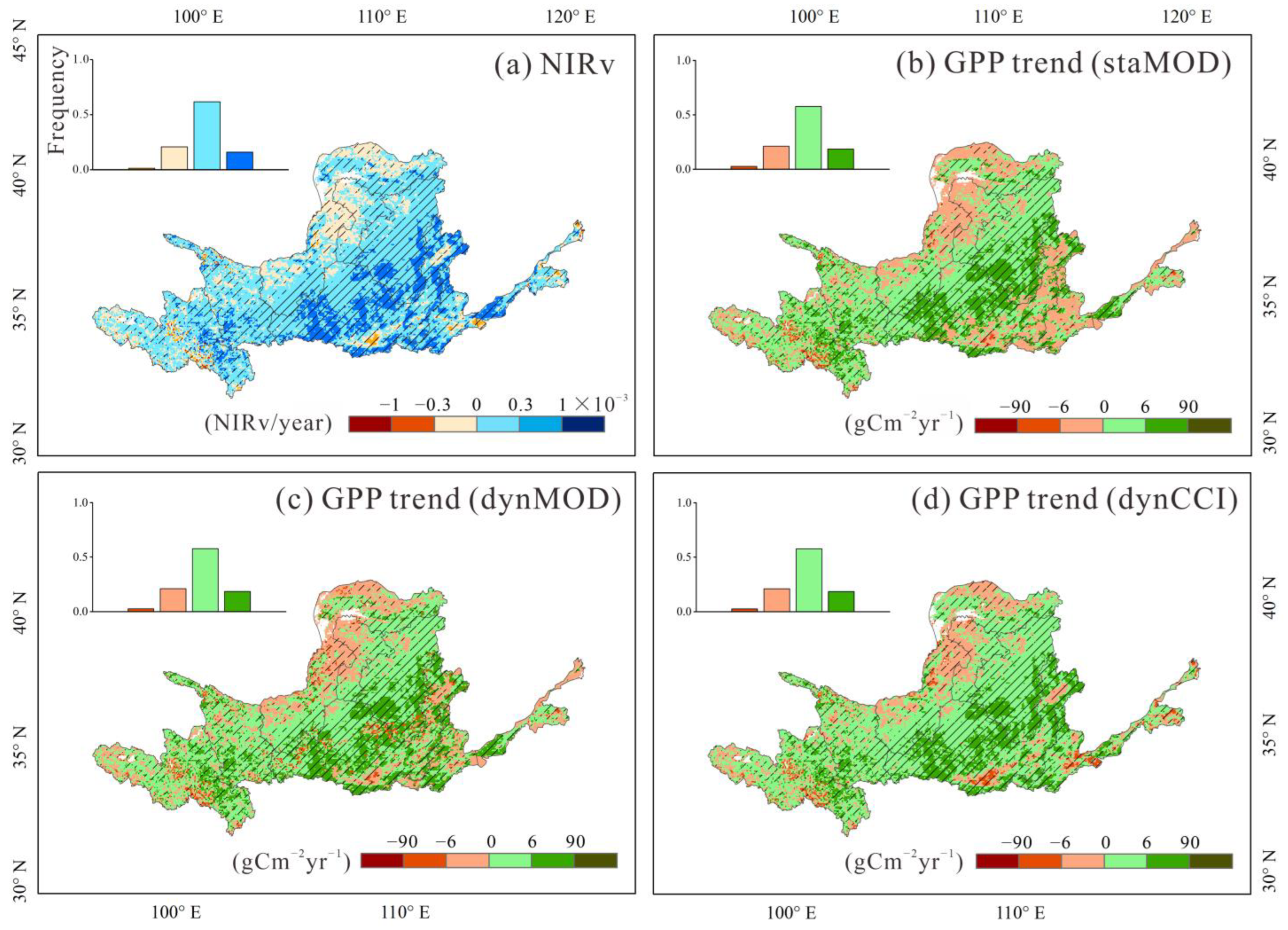

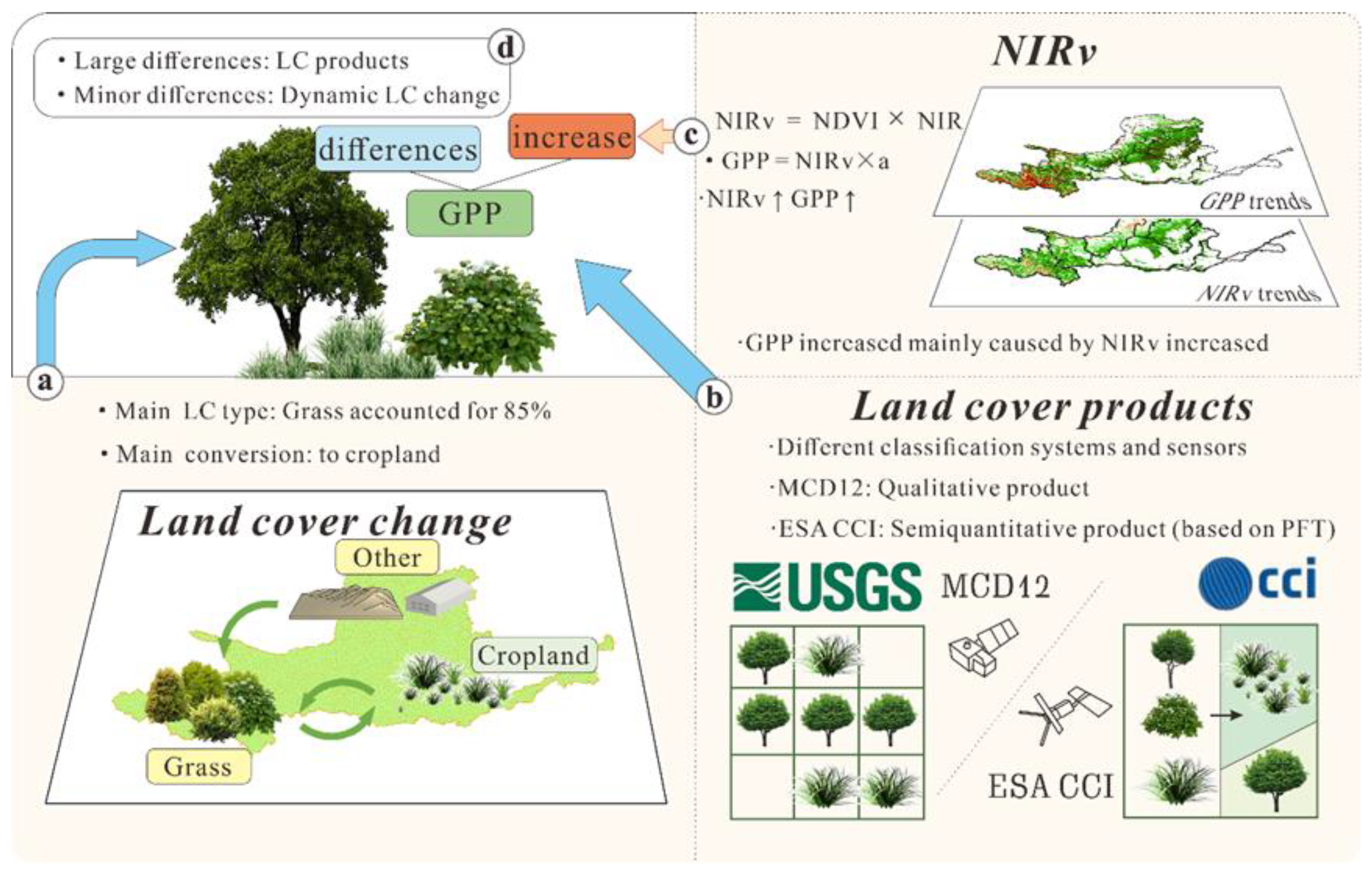
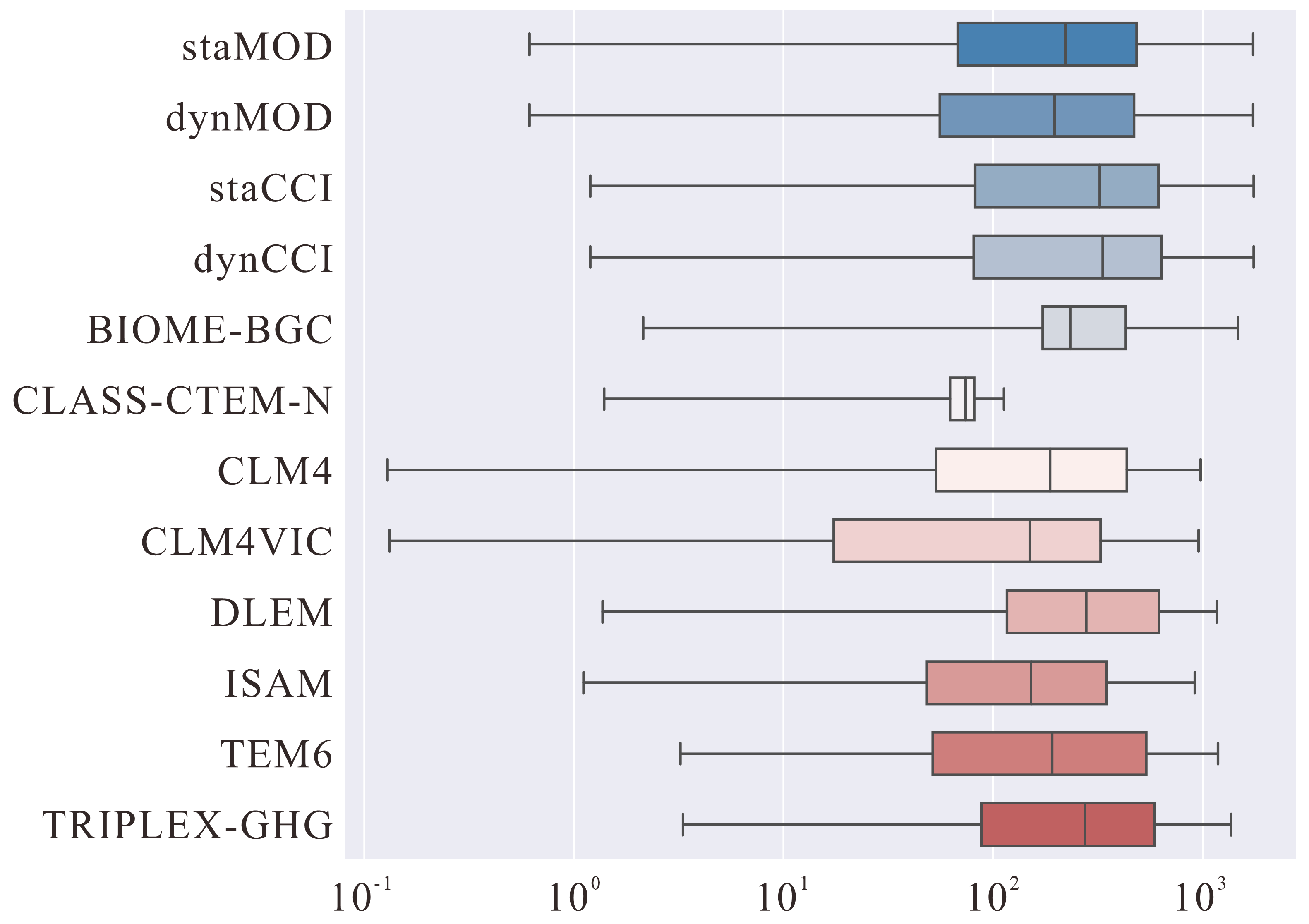
| MODIS | ESA CCI (PFTs) |
|---|---|
| Deciduous broadleaf forest | Deciduous broadleaf tree |
| / | Evergreen broadleaf tree |
| Evergreen needleleaf forest | Evergreen needleleaf tree |
| Mixed forest | / |
| Closed shrub | Evergreen broadleaf shrub |
| Deciduous broadleaf shrub | |
| Sparse shrub | Evergreen needleleaf shrub |
| Deciduous needleleaf shrub | |
| Grass | Grass |
| Land Cover Type | Linear Regression | R2 | RMSE | Bias |
|---|---|---|---|---|
| DBF | GPP = 64.07·NIRv − 2.20 | 0.65 | 2.14 | 0.14 |
| EBF | GPP = 44.50·NIRv + 2.60 | 0.45 | 2.02 | 0.56 |
| ENF | GPP = 64.51·NIRv − 1.41 | 0.65 | 1.96 | 0.10 |
| MF | GPP = 59.49·NIRv − 2.93 | 0.70 | 1.86 | 0.04 |
| SHR | GPP = 36.18·NIRv − 0.87 | 0.70 | 0.72 | −0.03 |
| GRA | GPP = 68.13·NIRv − 1.62 | 0.74 | 1.94 | 0.05 |
| CRO-C3 | GPP = 55.38·NIRv − 1.97 | 0.65 | 2.14 | 0.14 |
Disclaimer/Publisher’s Note: The statements, opinions and data contained in all publications are solely those of the individual author(s) and contributor(s) and not of MDPI and/or the editor(s). MDPI and/or the editor(s) disclaim responsibility for any injury to people or property resulting from any ideas, methods, instructions or products referred to in the content. |
© 2023 by the authors. Licensee MDPI, Basel, Switzerland. This article is an open access article distributed under the terms and conditions of the Creative Commons Attribution (CC BY) license (https://creativecommons.org/licenses/by/4.0/).
Share and Cite
Jin, J.; Hou, W.; Wang, L.; Wang, S.; Wang, Y.; Zhu, Q.; Fang, X.; Ren, L. Non-Ignorable Differences in NIRv-Based Estimations of Gross Primary Productivity Considering Land Cover Change and Discrepancies in Multisource Products. Remote Sens. 2023, 15, 4693. https://doi.org/10.3390/rs15194693
Jin J, Hou W, Wang L, Wang S, Wang Y, Zhu Q, Fang X, Ren L. Non-Ignorable Differences in NIRv-Based Estimations of Gross Primary Productivity Considering Land Cover Change and Discrepancies in Multisource Products. Remote Sensing. 2023; 15(19):4693. https://doi.org/10.3390/rs15194693
Chicago/Turabian StyleJin, Jiaxin, Weiye Hou, Longhao Wang, Songhan Wang, Ying Wang, Qiuan Zhu, Xiuqin Fang, and Liliang Ren. 2023. "Non-Ignorable Differences in NIRv-Based Estimations of Gross Primary Productivity Considering Land Cover Change and Discrepancies in Multisource Products" Remote Sensing 15, no. 19: 4693. https://doi.org/10.3390/rs15194693
APA StyleJin, J., Hou, W., Wang, L., Wang, S., Wang, Y., Zhu, Q., Fang, X., & Ren, L. (2023). Non-Ignorable Differences in NIRv-Based Estimations of Gross Primary Productivity Considering Land Cover Change and Discrepancies in Multisource Products. Remote Sensing, 15(19), 4693. https://doi.org/10.3390/rs15194693







